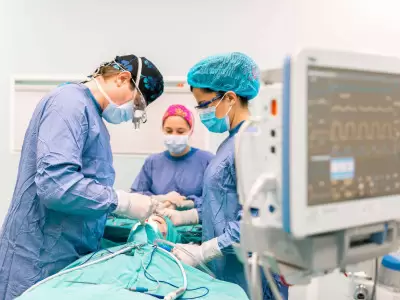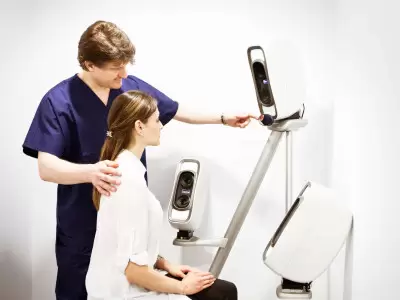Surgical Treatment of Nasal Obstruction
Surgical Treatment of Nasal Obstruction
Operations Directed to the Lower Nasal Turbinate
In the treatment of nasal obstruction that arise due to inferior nasal turbinate hypertrophy (generally cause more complaints at nights), reducing of size of the turbinates as necessary may be achieved with different methods. Inferior turbinates that have a very important role in the functions of the nose should never be excised completely. Following these types of surgeries, which have been frequently performed in the past, the functions of the nose deteriorates irreversibly, in addition to its negative effects on the physiology of respiration, it is sometimes or never possible to resolve complaints like dryness, rind forming, recurrent infections and the feeling of burning that forms in the nose. Therefore, when lower concha is being reduced today, techniques that do not damage the mucosa of the functional outer surface are preferred.
In most of the patients having a curved septum, the lower turbinate of the opposite nasal passage which is wider in volume enlarges. Therefore, in most of the septum deviation surgeries, in order to achieve a satisfactory result in respect to respiration, during the same surgery, especially reducing of the turbinate/turbinates in the nasal passage opposite the curvature is required with an appropriate intervention.
The most frequently used methods applied to reduce the size of lower turbinates are radiofrequency reduction of the tissue volume under the mucosa without damaging it and in cases in which bony parts are also enlarged, reducing the soft tissue and bone tissue under the mucosa by partial excision with different instruments or technologies (endoscopic reduction).
As a structural variation, an air cell can be present inside the middle turbinate (concha bullosa). Enlargement of this air cell during growth inhibits the air flow in the middle nasal passage and at the same time may result in chronic sinusitis due to the obstruction in the sinus discharge channels located in the outer wall of the passage. Concha bullosa plasty should be applied to the middle turbinate that leads to these kinds of problems by using appropriate endoscopic surgery techniques. Though complete resection of middle turbinate does not result in a serious problem in the physiology of the nose, since these structures have a role as a guide for sinus interventions that may be performed in the future, they are not generally preferred to be removed completely.
Reducing of lower turbinate with radiofrequency
It is based on the principle of healing of the heat damage by constriction and hardening which is followed by the administration of radiofrequency energy to the soft tissues with rich vessel content found beneath the mucosa of lower turbinates. The hard scar tissue, forming within 2-3 months following the process results in shrinking in the turbinates and also prevents the widening that is formed with external stimuli or the position of the body.
In patients who do not require intervention to another pathology, lower turbinate radiofrequency can be applied under local anesthesia in the setting of an examination room (figure 1).
Figure 1: Application of radiofrequency to lower turbinate. The turbinate shrinks following the application.
Concha radiofrequency operation that last approximately 5-10 minutes, can be performed easily during other operations such as nose surgeries for aesthetic or functional purposes, surgeries for chronic sinusitis and other surgeries that are performed in patients with the complaint of nasal congestion.
Since cutting is not performed during the operation, bleeding does not occur and therefore application of a packing is not required.
After this painless operation following an appropriate local anesthesia, patients can return back tot their daily activities immediately.
The ratio of yielding a successful result of the radiofrequency process that can be applied safely and comfortably in the treatment of lower turbinate enlargement within a single session is around 80%. Following the operation, the swelling that is formed in the lower turbinate or nasal congestion due to the tissue reaction on the surface of the mucosa may increase. The expected results of radiofrequency application emerge within 15-20 days. In nearly the 1/5 of the patients, since the opening of the nose is not completely obtained, the process may have to be applied again after a waiting period of 2-3 months.
In patients who yield successful result with radiofrequency, lower turbinate may enlarge again within 6 months-1 year if diseases like allergic rhinitis, vasomotor rhinitis are present, if the patients continuously stay in an environment with dry and polluted air, cigarette smoke or in a cold environment or if they use vasodilatators. Repetition of the radiofrequency process or endoscopic concha reduction is recommended in these patients.
Though there is a disadvantage of recurrence of complaints, concha radiofrequency process is one of the most preferred procedures by the patients and the physicians since it has advantages like a high success rate, since it does not require nasal packing and it may be applied under local anesthesia and does not cause bleeding.
Endoscopic Reduction of Lower Turbinate
It is the partial removal of soft tissues sometimes with turbinate bone that are located under the lower turbinate mucosa.
This method usually is applied when the bone within the turbinate has an important role in enlargement, when desired results can not be obtained with radiofrequency applications, when the turbinate is extremely large or deformative or radiofrequency is not preferred due to the probability of failure.
The process is usually conducted under general anesthesia and when applied with micro debrider technology lasts for 5-10 minutes. Since the dimensions of the microdebrider device developed for turbinates are very small, the integrity of the mucosa is not destroyed during the process and therefore, endoscopic reduction surgeries may now be performed without the usage of packing. Due to rich blood vessel content of lower (inferior) turbinates, patients are recommended to rest for 72 hours against the probability of bleeding after the surgery.
Following the endoscopic turbinate reduction operation which is a highly effective method, turbinates are reduced to an important extent. With the help of new microdebriders, the posterior parts of the lower turbinates can also be reached and these widened or deformed parts can successfully be reduced. In some patients having this condition, partial resection or the application of radiofrequency to the posterior part of lower turbinates may be preferred.
Even the endoscopic reduction method is a very effective technique, lower turbinates may enlarge again in the long term in some patients. Application of radiofrequency with local anesthesia yields good results in these patients.
Operations for Deviated – Curved Septum
When decision to perform surgery directed to deviation is taken, the complaints of the patient, the negative impact of the nasal obstruction on health and quality of life should be considered along with the findings of the examination.
In patients diagnosed with obstructing sleep apnea, the deviations and turbinate enlargements inside the nose may required to be eliminated in order to facilitate the usage of CPAP device.
In patient with nasal obstruction complaint that is determined to be due to septum deviation, no alternative other than surgical treatment is present.
In deviation that are close to the back of the nose, with no excessive deformation in the cartilage that forms the anterior half of the septum and that do not include the bony skeleton of the nose, successful results may be obtained with standard operations that lasts for 20-30 minutes, applied through the nostrils.
In the presence of the defined problems, for patients who had undergone nose surgery and/or aesthetic interventions are planned in the same operation, "surgery with open technique is generally preferred.
Today, with this method that has been preferred in aesthetic operations more frequently, it is possible to ideally and permanently correct the deviations of the cartilage and the bones without changing the outer appearance of the nose. In patients with cartilage deficiency or abnormality due to a previous operation, if sufficient amount of cartilage in the septum is not present, then pieces of cartilage taken from the ear or the ribs may have to be used in the nose.
With the surgery techniques developed today, it is now possible to perform deviation and aesthetic nose surgeries without the use of packing and this has an important contribution to the comfort of the patients after the surgery.
If the patients who have to undergo surgery due to deviation are thinking of undergoing an aesthetic surgery as well, the most ideal approach is performing the two operations at the same time. The usage of excess cartilage or bone which excised to correct the deviation, for the aesthetic part of the operation is the most important advantage of the surgery that is performed simultaneously.
Deviation surgeries are preferably performed under general anesthesia and may last for 20-30 minutes with closed technique and for 1 to 2.5 hours with open technique according to the extent of the problem and the need for obtaining cartilage tissue from the ear or the rib.
In patients who do not undergo a process that requires the usage of packing for lower concha at the same surgery, the operation directed for deviation is also performed without using intranasal packing.
Patients usually stay at the hospital on the day of the surgery and discharged the next day after cleaning the nose.
It is usually sufficient for patients to come back for controls for 2 or 3 times after the surgery. For dryness and rind formation that occurs for 2-3 weeks till the healing of the mucosa in the nose is completed, cleaning sprays containing saline and softening drops are used.
In patients who do not undergo open technique surgery due to extreme cartilage deviation that affects the outer appearance or in patients who do not undergone an intervention for aesthetic purposes, the outer appearance of the nose does not change after the surgery, and swellings or purple color change do not occur around the face and the eyes.
The patients have to protect their noses from impacts for a period of 8 weeks. They can start sports activities after 2 weeks, and start swimming after 1 month.
There is no objection to wear glasses for patients undergoing surgery for deviation.
Operations for Nasal Valve Problems
Nasal valve problems are observed in two different types as internal narrowing or external nasal valve failure.
Internal narrowing originates from the narrowing of nasal passage in the valve region due to the deviations that are found in the anterior upper part of cartilage septum, close to the nasal entrance. In the treatment, with the open technique septoplasty surgery, this region is revealed and the deviation is corrected and also the valve region may be widened to facilitate air flow with the help of cartilage grafts when necessary.
The main problem in external valve failure is the collapsing of nasal side walls while inhaling and narrowing the air passage. This problem results from the reverse curvature of the cartilaginous structures inside the wings of the nose or occurs when it can not withstand the vacuum effect created by the air flow due to reasons like aesthetic surgeries, traumas or aging. In the treatment, techniques like supporting the weak regions with pieces of cartilage, correction of the cartilage angle that results in narrowing and preventing this collapsing with the help of sutures are used.






Comment
Your Contact Information will not be shared in any way. * Required Fields